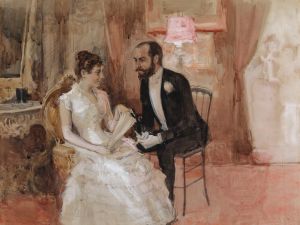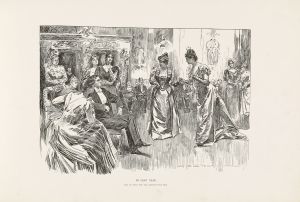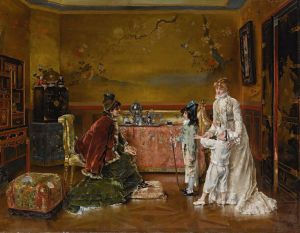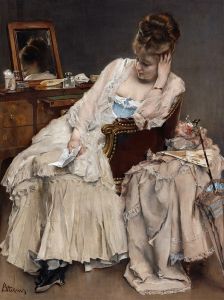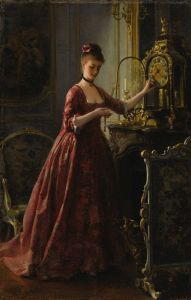
After the Ball
A hand-painted replica of Alfred Stevens’s masterpiece After the Ball, meticulously crafted by professional artists to capture the true essence of the original. Each piece is created with museum-quality canvas and rare mineral pigments, carefully painted by experienced artists with delicate brushstrokes and rich, layered colors to perfectly recreate the texture of the original artwork. Unlike machine-printed reproductions, this hand-painted version brings the painting to life, infused with the artist’s emotions and skill in every stroke. Whether for personal collection or home decoration, it instantly elevates the artistic atmosphere of any space.
"After the Ball" is a painting by the Belgian artist Alfred Stevens, created in 1874. Stevens was known for his detailed and elegant depictions of women, often capturing the nuances of contemporary fashion and domestic life in the 19th century. "After the Ball" is a prime example of his ability to blend realism with a keen sense of narrative and emotion.
The painting portrays a young woman seated in a lavishly decorated interior, presumably after returning from a ball. She is dressed in an elaborate evening gown, which suggests the opulence and social status of the subject. The woman's posture and expression convey a sense of fatigue and contemplation, as she appears to be lost in thought. This moment of quiet introspection contrasts with the likely vibrancy and excitement of the ball she has just attended.
Stevens' attention to detail is evident in the intricate rendering of the woman's dress, the textures of the fabrics, and the various objects that populate the room. The setting includes rich furnishings, a mirror, and other decorative elements that reflect the tastes and styles of the period. These details not only enhance the realism of the scene but also provide insight into the lifestyle and environment of the upper class during the late 19th century.
The use of light in "After the Ball" is particularly noteworthy. Stevens employs a soft, diffused light that gently illuminates the subject and the surrounding space. This lighting creates a serene and intimate atmosphere, further emphasizing the personal and reflective nature of the moment depicted. The subtle play of light and shadow also adds depth and dimension to the composition, enhancing the overall realism of the painting.
Alfred Stevens was a prominent figure in the art world during his time, and his works were highly regarded for their technical skill and emotional depth. "After the Ball" exemplifies his mastery in capturing the subtleties of human experience and the beauty of everyday moments. The painting is part of the collection at the Musée d'Orsay in Paris, which houses many of Stevens' works and other significant pieces from the 19th century.
In summary, "After the Ball" by Alfred Stevens is a masterful depiction of a young woman in a moment of quiet reflection after a social event. Through his meticulous attention to detail, skillful use of light, and ability to convey emotion, Stevens creates a compelling and intimate portrait that offers a glimpse into the life and times of the 19th-century upper class.








